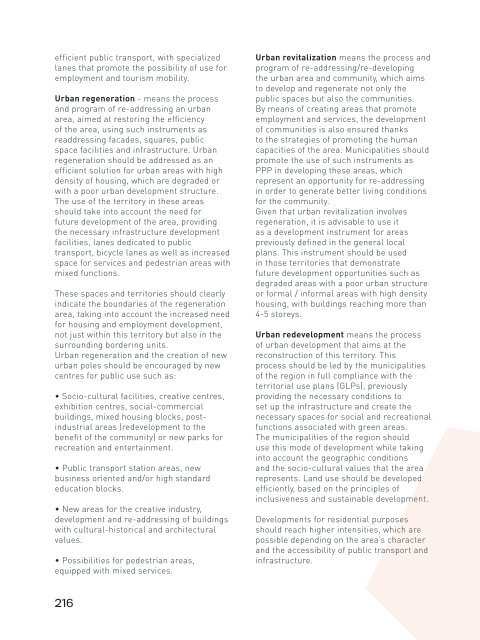Integrated Cross-Sectorial Plan of Tirana-Durres Area
The Albanian Government and the National Spatial Plan have identified the Tiranë-Durrës area, as one of the most important economic areas of the country, and of the Balkan region. To ensure a sustainable territorial and urban development of this area, the Ministry of Urban Development in cooperation with the National Territorial Planning Agency has taken the initiative to draft a Cross-sectoral Integrated Plan for the economic area Tiranë – Durrës. The metropolitan region under study includes territories administered by 5 municipalities: Tiranë, Durrës, Vorë, Shijak, Kamëz.
The Albanian Government and the National Spatial Plan have identified the Tiranë-Durrës area, as one of the most important economic areas of the country, and of the Balkan region. To ensure a sustainable territorial and urban development of this area, the Ministry of Urban Development in cooperation with the National Territorial Planning Agency has taken the initiative to draft a Cross-sectoral Integrated Plan for the economic area Tiranë – Durrës. The metropolitan region under study includes territories administered by 5 municipalities: Tiranë, Durrës, Vorë, Shijak, Kamëz.
You also want an ePaper? Increase the reach of your titles
YUMPU automatically turns print PDFs into web optimized ePapers that Google loves.
efficient public transport, with specialized<br />
lanes that promote the possibility <strong>of</strong> use for<br />
employment and tourism mobility.<br />
Urban regeneration - means the process<br />
and program <strong>of</strong> re-addressing an urban<br />
area, aimed at restoring the efficiency<br />
<strong>of</strong> the area, using such instruments as<br />
readdressing facades, squares, public<br />
space facilities and infrastructure. Urban<br />
regeneration should be addressed as an<br />
efficient solution for urban areas with high<br />
density <strong>of</strong> housing, which are degraded or<br />
with a poor urban development structure.<br />
The use <strong>of</strong> the territory in these areas<br />
should take into account the need for<br />
future development <strong>of</strong> the area, providing<br />
the necessary infrastructure development<br />
facilities, lanes dedicated to public<br />
transport, bicycle lanes as well as increased<br />
space for services and pedestrian areas with<br />
mixed functions.<br />
These spaces and territories should clearly<br />
indicate the boundaries <strong>of</strong> the regeneration<br />
area, taking into account the increased need<br />
for housing and employment development,<br />
not just within this territory but also in the<br />
surrounding bordering units.<br />
Urban regeneration and the creation <strong>of</strong> new<br />
urban poles should be encouraged by new<br />
centres for public use such as:<br />
• Socio-cultural facilities, creative centres,<br />
exhibition centres, social-commercial<br />
buildings, mixed housing blocks, postindustrial<br />
areas (redevelopment to the<br />
benefit <strong>of</strong> the community) or new parks for<br />
recreation and entertainment.<br />
• Public transport station areas, new<br />
business oriented and/or high standard<br />
education blocks.<br />
• New areas for the creative industry,<br />
development and re-addressing <strong>of</strong> buildings<br />
with cultural-historical and architectural<br />
values.<br />
• Possibilities for pedestrian areas,<br />
equipped with mixed services.<br />
Urban revitalization means the process and<br />
program <strong>of</strong> re-addressing/re-developing<br />
the urban area and community, which aims<br />
to develop and regenerate not only the<br />
public spaces but also the communities.<br />
By means <strong>of</strong> creating areas that promote<br />
employment and services, the development<br />
<strong>of</strong> communities is also ensured thanks<br />
to the strategies <strong>of</strong> promoting the human<br />
capacities <strong>of</strong> the area. Municipalities should<br />
promote the use <strong>of</strong> such instruments as<br />
PPP in developing these areas, which<br />
represent an opportunity for re-addressing<br />
in order to generate better living conditions<br />
for the community.<br />
Given that urban revitalization involves<br />
regeneration, it is advisable to use it<br />
as a development instrument for areas<br />
previously defined in the general local<br />
plans. This instrument should be used<br />
in those territories that demonstrate<br />
future development opportunities such as<br />
degraded areas with a poor urban structure<br />
or formal / informal areas with high density<br />
housing, with buildings reaching more than<br />
4-5 storeys.<br />
Urban redevelopment means the process<br />
<strong>of</strong> urban development that aims at the<br />
reconstruction <strong>of</strong> this territory. This<br />
process should be led by the municipalities<br />
<strong>of</strong> the region in full compliance with the<br />
territorial use plans (GLPs), previously<br />
providing the necessary conditions to<br />
set up the infrastructure and create the<br />
necessary spaces for social and recreational<br />
functions associated with green areas.<br />
The municipalities <strong>of</strong> the region should<br />
use this mode <strong>of</strong> development while taking<br />
into account the geographic conditions<br />
and the socio-cultural values that the area<br />
represents. Land use should be developed<br />
efficiently, based on the principles <strong>of</strong><br />
inclusiveness and sustainable development.<br />
Developments for residential purposes<br />
should reach higher intensities, which are<br />
possible depending on the area’s character<br />
and the accessibility <strong>of</strong> public transport and<br />
infrastructure.<br />
216
















